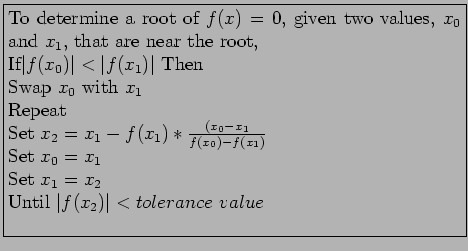Figure 3.2:
Graphical illustration of the Secant Method.
|
|
An algorithm for the Secant Method:

Table 3.2:
The Secant method for
 , starting from
, starting from
 , using a tolerance value of 1E-6.
, using a tolerance value of 1E-6.
![\begin{table}
\begin{center}
\includegraphics[scale=1]{figures/1.5.ps}
\end{center}\end{table}](img223.png) |
- If
 is not continuous, the method may fail.
is not continuous, the method may fail.
- An alternative stopping criterion for the secant method is when the pair of points being used are sufficiently close together.
- Table 3.2 shows the results from the secant method for the same function that was used to illustrate bisection.
- An objection is sometimes raised about the secant method. If the function is far from linear near the root, the successive iterates can fly off to points far from the root, as seen if Fig. 3.3.
- If the method is being carried out by a program that displays the successive iterates, the user can interrupt the program should such improvident behavior be observed. Also, if the function was plotted before starting the method, it is unlikely that the problem will be encountered, because a better starting value would be used.
Figure 3.3:
A pathological case for the secant method.
|
|
2004-12-28


